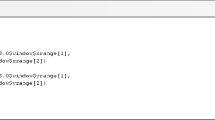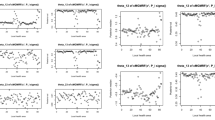Abstract
In this article, we focus on statistical models for binary data on a regular two-dimensional lattice. We study two classes of models, the Markov mesh models (MMMs) based on causal-like, asymmetric spatial dependence, and symmetric Markov random fields (SMFs) based on noncausal-like, symmetric spatial dependence. Building on results of Enting (1977), we give sufficient conditions for the asymmetrically defined binary MMMs (of third order) to be equivalent to a symmetrically defined binary SMF. Although not every binary SMF can be written as a binary MMM, our results show that many can. For such SMFs, their joint distribution can be written in closed form and their realizations can be simulated with just one pass through the lattice. An important consequence of the latter observation is that there are nontrivial spatial processes for which exact probabilities can be used to benchmark the performance of Markov-chain-Monte-Carlo and other algorithms.
Similar content being viewed by others
References
K. Abend, T. J. Harley, and L. N. Kanal, “Classifcation of binary random patterns,”IEEE Transactions on Information Theory vol. IT-11 pp. 538-544, 1965.
J. E. Besag, “Spatial interaction and the statistical analysis of lattice systems,” Journal of the Royal Society B vol. 36 pp. 192-225, 1974
P. Carnevali, L. Coletti, and S. Patarnello, “Image processing by simulated annealing,”IBM Journal of Research and Development vol. 29 pp. 569-579, 1985.
N. Cressie and J. L. Davidson, “Image analysis with partially ordered Markov models,” Computational Statistics and Data Analysis vol. 29 pp. 1-26, 1998.
J. L. Davidson, N. Cressie, and X. Hua, “Texture synthesis and pattern recognition for partially ordered Markov models,” Pattern Recognition vol. 32 pp. 1475-1505, 1999.
P. A. Devijver, “Image segmentation using causal Markov random field models,” in J. Kittler (ed.) Pattern Recognition, Lecture Notes in Computer Science, No. 301, Springer, Berlin: pp. 131-143, 1988.
I. G. Enting, “Crystal growth models and Ising models: Disorder point,” Journal of Physics C vol. 10 pp. 1379-1388, 1977.
S. Geman and D. Geman, “Stochastic relaxation, Gibbs distributions and the Bayesian restoration of images,” IEEE Transactions on Pattern Analysis and Machine Intelligence vol. PAMI-6 pp. 721-741, 1984.
J. K. Goutsias, “Mutually compatible Gibbs random fields,” IEEE Transactions on Information Theory vol. 35 pp. 1233-1249, 1989.
J. K. Goutsias, “Unilateral approximation of Gibbs random field images,” Computer Vision, Graphics, and Image Processing: Graphical Models and Image Processing vol. 53 pp. 240-257, 1991.
A. J. Gray, J. W. Kay, and D. M. Titterington, “An empirical study of the simulation of various models used for images,” IEEE Transactions on Pattern Analysis and Machine Intelligence vol. 16 pp. 507-513, 1994.
O. Haeggstroem and K. Nelander, “Exact sampling from anti-monotone systems,” Statistica Neerlandica vol. 52 pp. 360-380
E. Ising, “A contribution to the theory of ferromagnetism,” Zeitschrift fur Physik vol. 31 pp. 253-258, 1925.
M. S. Kaiser and N. Cressie, “The construction of multivariate distributions from Markov random fields,” Journal of Multivariate Analysis vol. 73 pp. 199-220, 2000.
R. Kindermann and J. L. Snell, Markov Random Fields and Their Applications. American Mathematical Society, Providence, RI, 1980.
V. Lacroix, “Pixel labeling in a second-order Markov mesh,” Signal Processing vol. 12 pp. 59-82, 1987.
J. H. Lee, M. S. Kaiser, and N. Cressie, “Multiway dependence in exponential family conditional distributions,” Journal of Multivariate Analysis (forthcoming, 2001).
N. J. McMillan and L. M. Berliner, “Hierarchical image reconstruction using Markov random fields,” in J. M. Bernardo et al. (eds) Bayesian Statistics 5, Oxford University Press: Oxford, pp. 675-683, 1996.
J. Moller, “Perfect simulation of conditionally specified models,” Journal of the Royal Statistical Society B vol. 61 pp. 251-264, 1999.
G. G. Potamianos and J. K. Goutsias, “Partition function estimation of Gibbs random field images using Monte Carlo simulations,” IEEE Transactions on Information Theory vol. 39 pp. 1322-1332, 1993.
B. Prum and J. C. Fort, Stochastic Processes on a Lattice and Gibbs Measures. Kluwer Academic Publishers: Dordrecht, Netherlands.
W. Qian and D. M. Titterington, “Pixel labelling for three-dimensional scenes based on Markov mesh models,” Signal Processing vol. 22 pp. 313-328, 1991.
H. Tjelmeland and J. Besag, “Markov random fields with higher order interactions,” Scandinavian Journal of Statistics vol. 25 pp. 415-433, 1998.
T. R. Welberry and R. Galbraith, “A two-dimensional model of crystal-growth disorder,” Journal of Applied Crystallography vol. 6 pp. 87-96, 1973.
T. R. Welberry and R. Galbraith, “The effect of non-linearity on a two-dimensional model of crystal growth disorder,” Journal of Applied Crystallography vol. 8 pp. 636-644, 1975.
T. R. Welberry, “Solution of crystal growth models by imposition of symmetry,” Proceedings of the Royal Society of London A vol. 353 pp. 363-376, 1977.
Author information
Authors and Affiliations
Rights and permissions
About this article
Cite this article
Cressie, N., Liu, C. Binary Markov Mesh Models and Symmetric Markov Random Fields: Some Results on their Equivalence. Methodology and Computing in Applied Probability 3, 5–34 (2001). https://doi.org/10.1023/A:1011461923517
Issue Date:
DOI: https://doi.org/10.1023/A:1011461923517




